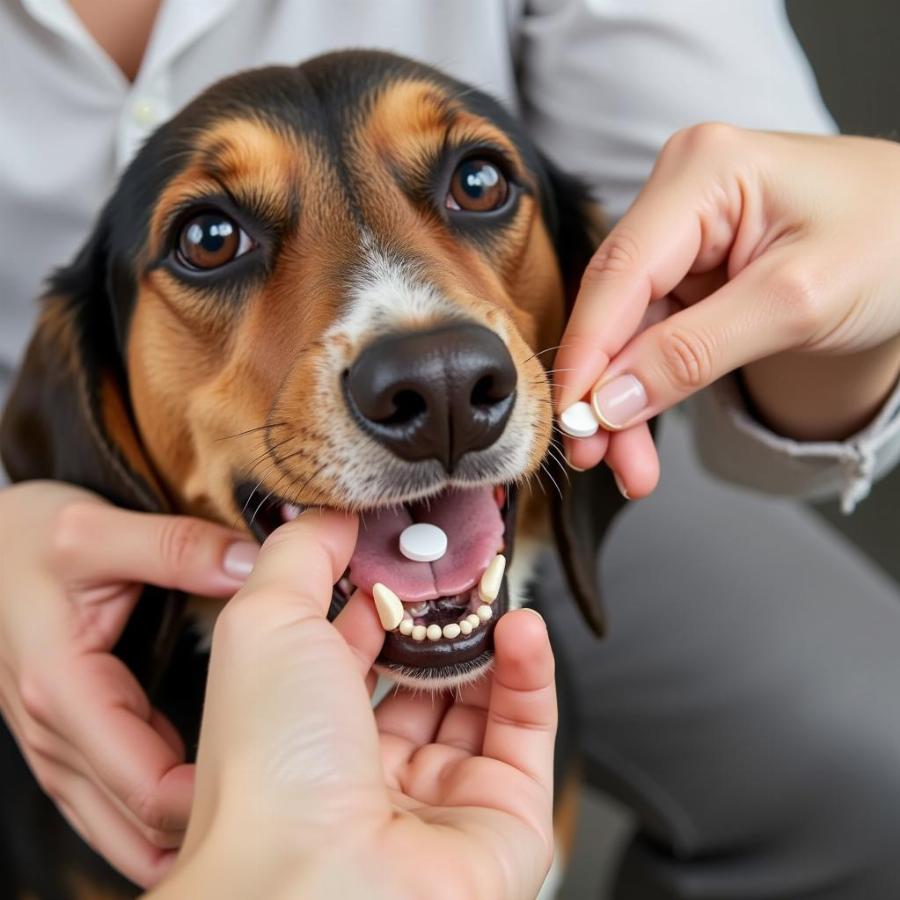Soloxine is a common medication prescribed for dogs with hypothyroidism, a condition where the thyroid gland doesn’t produce enough hormones. This comprehensive guide will delve into the uses, dosage, side effects, and important considerations for administering Soloxine to your canine companion. It’s crucial to understand how this medication works and how to ensure its safe and effective use for your furry friend.
What is Soloxine and How Does it Work in Dogs?
Soloxine (generic name: levothyroxine sodium) is a synthetic form of the thyroid hormone thyroxine (T4). In dogs with hypothyroidism, the body doesn’t produce enough T4, leading to a range of symptoms like weight gain, lethargy, hair loss, and skin problems. Soloxine supplements the missing hormone, restoring normal bodily functions. The medication is absorbed in the intestines and then travels through the bloodstream to various tissues, mimicking the action of naturally produced T4. This helps regulate metabolism, energy levels, and overall health.
Dosage and Administration of Soloxine for Dogs
The correct dosage of Soloxine is crucial for its effectiveness. It is typically determined based on the dog’s weight and the severity of their hypothyroidism. Your veterinarian will prescribe the appropriate dosage and monitor your dog’s thyroid hormone levels through regular blood tests to adjust the dose as needed. It’s essential to never adjust the dosage yourself without consulting your vet. Soloxine is usually given orally once or twice a day, preferably on an empty stomach for optimal absorption. Consistency in administration is key for maintaining stable thyroid hormone levels.
 Administering Soloxine to a dog
Administering Soloxine to a dog
Potential Side Effects of Soloxine in Dogs
While Soloxine is generally safe, some dogs may experience side effects, especially if the dosage is too high. These side effects can include increased thirst and urination, increased appetite, weight loss, restlessness, panting, and behavioral changes. If you notice any of these signs, contact your veterinarian immediately. They may need to adjust the dosage or explore alternative treatment options.
Monitoring Your Dog on Soloxine
Regular monitoring is essential to ensure the effectiveness and safety of Soloxine therapy. Your veterinarian will typically recommend follow-up blood tests to measure thyroid hormone levels. These tests help determine if the dosage is appropriate and if the medication is working as intended. Consistent monitoring is key for managing hypothyroidism effectively.
When Should I Talk to My Vet About Soloxine?
If your dog exhibits symptoms of hypothyroidism, such as lethargy, weight gain, hair loss, or skin problems, it’s crucial to consult your veterinarian. They will conduct a thorough examination and blood tests to diagnose the condition and determine the appropriate course of treatment.
What Happens if My Dog Misses a Dose of Soloxine?
If you miss a dose of Soloxine, give it to your dog as soon as you remember. However, if it’s almost time for the next dose, skip the missed dose and continue with the regular schedule. Do not double the dose to catch up.
Can Soloxine Interact with Other Medications?
Soloxine can interact with certain medications, such as antacids, iron supplements, and some seizure medications. Inform your veterinarian about all medications your dog is currently taking, including supplements and over-the-counter drugs, to avoid potential interactions.
Expert Insights on Soloxine in Dogs
Dr. Emily Carter, a veterinary endocrinologist, emphasizes, “Accurate diagnosis and appropriate dosing are crucial for successful Soloxine therapy. Regular monitoring and open communication with your veterinarian are essential for optimizing treatment and ensuring your dog’s well-being.”
Dr. Robert Miller, DVM, adds, “Soloxine can significantly improve the quality of life for dogs with hypothyroidism. With proper management and monitoring, affected dogs can live long, healthy, and happy lives.”
Conclusion
Soloxine is an effective treatment for hypothyroidism in dogs, helping restore their health and vitality. By understanding the proper dosage, administration, potential side effects, and the importance of regular monitoring, you can help ensure the successful management of your dog’s condition. Always consult with your veterinarian for any concerns or questions regarding Soloxine and your furry friend’s health.
FAQs
- How long does it take for Soloxine to start working in dogs? It typically takes several weeks to a few months for Soloxine to fully take effect and for symptoms to improve.
- Can I give my dog Soloxine with food? While it’s generally recommended to give Soloxine on an empty stomach, your veterinarian may advise otherwise based on your dog’s individual needs.
- Is Soloxine expensive? The cost of Soloxine varies depending on the dosage and your location.
- Are there any natural alternatives to Soloxine? While some natural remedies are touted for hypothyroidism, none have been scientifically proven to be as effective as Soloxine. Consult your veterinarian before trying any alternative treatments.
- What if my dog accidentally overdoses on Soloxine? Contact your veterinarian or an emergency animal hospital immediately if you suspect an overdose.
You Might Also Be Interested In:
[Link to other related articles on Beaut Dogs, if any]
Beaut Dogs: Your Trusted Source for Canine Care
Beaut Dogs is your go-to resource for all things related to dog care, providing reliable and insightful information to help you navigate the world of canine companionship. From breed information to health and nutrition guidance, we’re dedicated to helping you provide the best possible care for your furry friend. When you need assistance, please contact us at [email protected] (Email address) for detailed and accurate answers from Beaut Dogs.